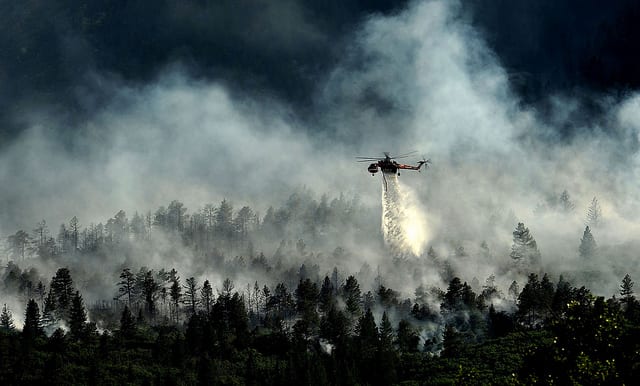 Image courtesy of US Air Force
Image courtesy of US Air Force
Fire and Fury: Climate Change in California
Wildfires recently decimated California. Unfortunately, California, and many western states, are very familiar with the looming threat of wildfires. What makes California so susceptible to wildfires? The west’s arid climate intensified by rising temperatures due to climate change has brought on some of the worst wildfires the west has known in recent years. The problem may only get worse.
Wildfire threat in California is only expected to increase with climate change. Over the past 5 years, California endured one of the state’s most intense droughts ever recorded. Today, nearly half of the state is still experiencing abnormally dry conditions. With rising global temperatures, large wildfire risk could increase as much as 50% as soon as 2100. These factors make the state increasingly vulnerable to wildfires.
The Camp Fire in Northern California has left a path of destruction. The fire reportedly reached speeds as high as one football field per second due to high winds, translating to over 80 football fields a minute, last week. The death toll has risen to over 70 people and nearly 1,000 citizens are unaccounted for, earning the title of the most deadly fire in California’s history. The wildfire began November 8th, a day with strong winds and plenty of parched vegetation from lingering drought to act as fuel. Within a week, the Camp Fire burned through 150,000 acres in Northern California. Simultaneously, another wildfire, known as the Woolsey Fire, devastated homes in Southern California. The Woolsey Fire ravaged 98,362 acres and killed at least 3 people. While drought feeds the fires, they typically occur due to human activity such as lit cigarette butts or unattended campfires. Reportedly 90% of all wildfires are caused by humans.
It is important to note that natural wildfires are essential for ecosystem health in the west. Ash from fires produce essential nutrients for ecosystem regeneration and promote organism biodiversity. Many forest management programs conduct prescribed burns, meaning controlled brush piles are lit to deliver essential nutrients under safe conditions. Prescribed burns also reduce the likelihood of large wildfires because they remove potential fuel sources such as low lying vegetation or broken tree limbs. While fires are vital for ecosystems, climate change has intensified the size and scope of wildfires, making them unsafe.
Today, wildfires in California are actively pushing hundreds of thousands out of their homes and have claimed the lives of far too many. The wildfires in California are intensified by climate change and are a direct threat to the safety of American citizens in the homeland. Fire management practices are essential in providing ecosystem health and delivering protection from large fires, but its success can only go so far. Mitigating climate change would help diminish the intensification and growth of uncontrollable wildfires. By lowering carbon emissions, the country can decrease the likelihood of future fires like the Camp Fire. The United States has the duty to protect its citizens and owes the nation smart climate action.





